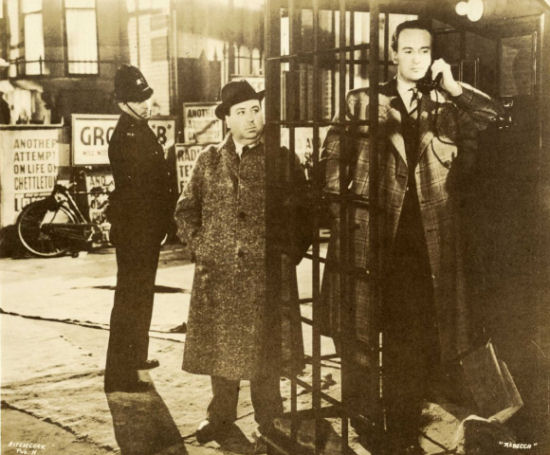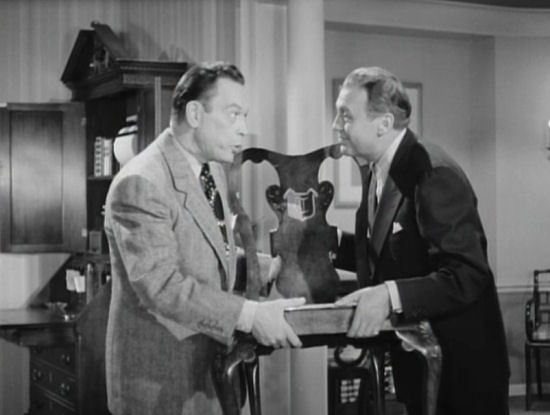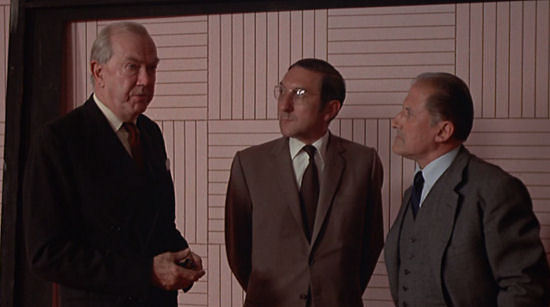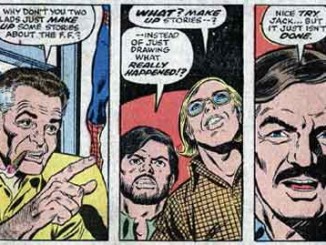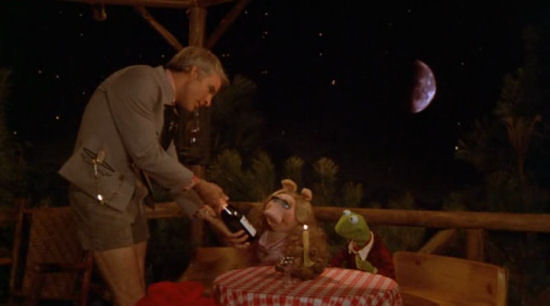 The term “cameo appearance” was coined by producer Michael Todd to describe the number of small roles filled by big name stars in his 1956 film Around The World In 80 Days. But Todd was merely putting a name to something that had been a part of films all the way back to the Silent Era and would continue right to the present day. Here is a chronological look at perhaps the greatest of the hundreds and maybe even thousands of cameo appearances that have been made in the movies.
The term “cameo appearance” was coined by producer Michael Todd to describe the number of small roles filled by big name stars in his 1956 film Around The World In 80 Days. But Todd was merely putting a name to something that had been a part of films all the way back to the Silent Era and would continue right to the present day. Here is a chronological look at perhaps the greatest of the hundreds and maybe even thousands of cameo appearances that have been made in the movies.
Elinor Glyn In It (1927) -As described in a two-part Cosmopolitan Magazine serial by Elinor Glyn, “It” is “that quality possessed by some which draws all others with its magnetic force. With ‘It’ you win all men if you are a woman and all women if you are a man. ‘It’ can be a quality of the mind as well as a physical attraction… The possessor of ‘It’ must be absolutely unselfconscious and must have that magnetic ‘sex appeal’ which is irresistible..” When Paramount decided to turn Glyn’s piece into a film, there was only one starlet in their studio they knew they cast in the role of the girl with “It” – Clara Bow. And to help explain the concept of “It” to other characters in the film and the audience, the studio had Glyn appear in the movie herself. Not only that, in one of the first instances of product placement, issues of Cosmopolitan are also seen. Although Bow was a star at the time of its release, the film proved such a sensation that the actress was ever after known as “The ‘It’ Girl.”
Alfred Hitchcock in Rebecca (1940) – If anyone’s name is synonymous with cameo appearances it would be director Alfred Hitchcock. Hitch knew the value of self-promotion and through his walk on roles in his films and appearances in his films’ trailers he was as easily recognizable as any big star of the time. He made his first on screen appearance in a newsroom scene in 1926’s The Lodger but would only appear sporadically until his move to America. Beginning with his first Hollywood studio film, Rebecca, where he stood behind star George Sanders in a phone booth, Hitchcock would make an appearance in every single one of his films for the rest of his career. Sometimes that would prove to be a tricky proposition, such as for Lifeboat, but it was a savvy move that helped insure that his name became its own brand.
Raymond Chandler in Double Indemnity (1943) – As creator of the detective Philip Marlow, Chandler was one of the shapers of the hardboiled detective genre. It seems only natural that when Chandler began working in films, his first screenplay would help define cinema’s equivalent – the film noir. By all accounts Chandler and Double Indemnity director Billy Wilder never did get along all that well, so it came as a bit of a surprise two years ago when it was realized that the gentleman reading a newspaper whom star Fred MacMurray walks past at an early point in the film is Chandler himself. Given their contentious relationship, it is not surprising that neither Chandler nor Wilder ever mentioned the appearance. It is a shock, though, that Chandler’s obvious cameo went unnoticed and unremarked upon for nearly 67 years until it was finally discovered in 2009.
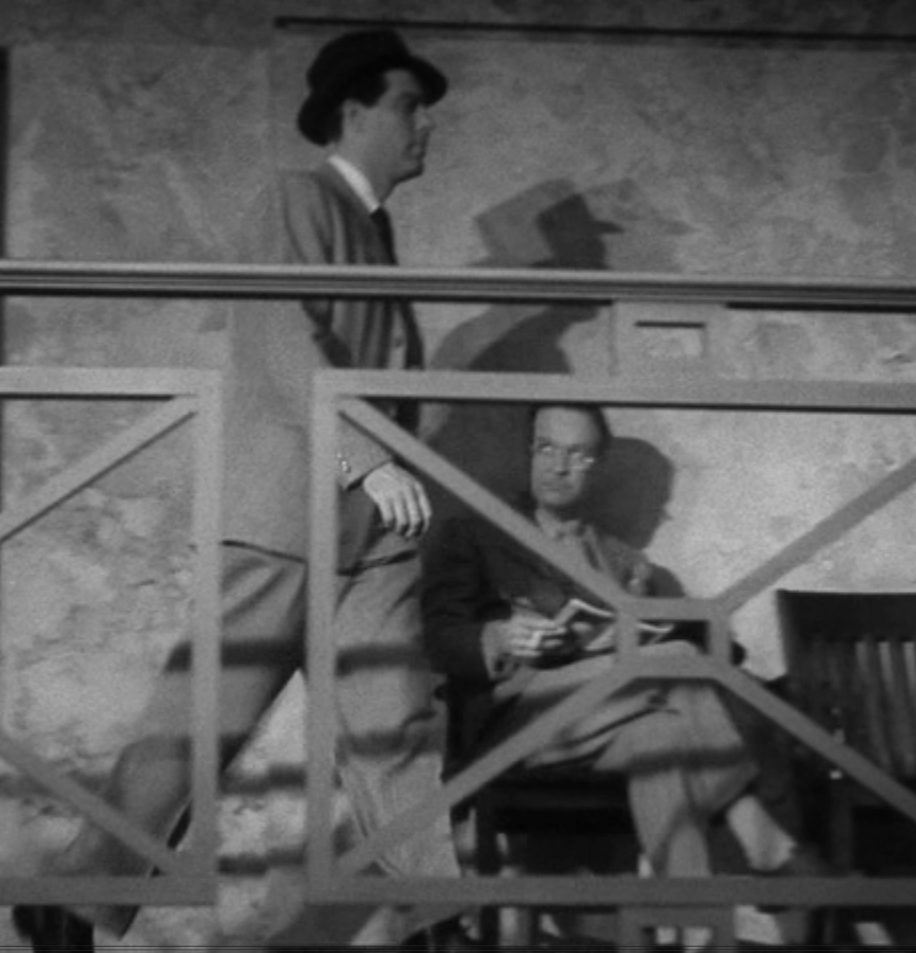
Jack Benny in It’s In The Bag (1945) – One of the most famous show business feuds from the 1930s and 40s wasn’t really a feud at all, but a running gag between two friends. Jack Benny and Fred Allen were comedians who got their start in vaudeville, where they formed a lifelong friendship. By the mid-1930s, they each had their own popular radio shows that aired on Sunday evenings, albeit at different times. During a 1937 broadcast, Allen made took a swipe at Benny’s ability to play the violin. (Benny’s bad violin skills, as well as his vanity and cheapness, were all part of his comedy persona only, and by all accounts were pretty much exactly the opposite of the comedian when he was off-mic.) Benny heard the comment, and made a good natured jab at his friend on his own show later that evening and the back and forth continued for more than a decade. Never mind the fact that they each appeared on the other’s programs, people believed that they were actual blood enemies. That perception was furthered by the 1940 comedy Love Thy Neighbor in which both comics starred as their feuding radio personas. But for as funny as that film was, it is outdone by Benny’s single scene in Allen’s 1945 comedy It’s In The Bag. Allen stars as a man who realizes that the key to a $12 million inheritance lies in one of the five chairs he just sold. Guess who happens to have come into ownership of one of the chairs.
Bryan Forbes in A Shot In The Dark (1964) – Hiding behind an acoustic guitar and the screen name of “Turk Thrust,” British actor/writer/director Forbes makes his appearance in the second Pink Panther film as guard at a nudist camp that Inspector Clouseau (Peter Sellers) and Maria (Elke Summers) are attempting to gain entrance to in the course of their investigation. Forbes was a friend of Sellers and had created a pop star persona with the name of Turk Thrust for him. Sellers never used the character although he did go on to do – more films as Clouseau. Forbes went on to direct such films as King Rat (1965) and The Stepford Wives (1975) while Turk Thrust made a reappearance of sorts in The Curse Of The Pink Panther (1983) when Roger Moore made a quick cameo under the nom-de-screen of Turk Thrust II.
Graham Greene in Day For Night (La Nuit Americaine) (1973) – Sometimes a cameo appearance can go unrecognized by a film’s audience. It is another thing for a cameo to go unrecognized by a film’s director. While Francois Truffaut was filming his story of a filmmaker struggling to complete his latest project, Greene was introduced to the director as a retired English businessman living on the Cote d’Azur. Trufaut cast the writer in a small role as a British insurance company representative who arrives at the Victorine Studios in Nice. Reportedly, Trufaut was upset to learn that the British man was actually the famous novelist and critic, as he was a fan and would have loved to talk with him.
Marshal McLuhan in Annie Hall (1977) – In Woody Allen’s classic comedy about New York and New Yorkers, the characters played by the director and Diane Keaton are standing in line for a movie when he hears a man in behind him pontificating about Canadian media theorist Marshall McLuhan. Annoyed that the man is getting his facts wrong, Allen steps out of line, breaks the film’s fourth wall and begins telling the audience how irritated he is. The man notices, steps up next to Allen and tries to speak to the audience in his own defense. The two begin to debate until Allen trumps the man’s argument by pulling McLuhan out from behind a lobby display to affirm that he and not the other man is right about McLuhan’s work. Not only does the scene work in conjunction with several other comedic scenes that break the reality of the love story that Allen is telling, there’s an added layer of humor if one is familiar with McLuhan’s theories about how society shapes media and media shapes society. And besides, who hasn’t agreed with Allen’s scene capping line “Don’t you wish reality was really like this?”
Steve Martin in The Muppet Movie (1979) – Jim Henson’s delightful The Muppet Movie is chockablock full of big name stars in fleetingly small roles – from Dom Deluise as the Hollywood agent vacationing in the Florida everglades who tells Kermit the Frog he needs to head to Los Angeles to become a movie star to Orson Welles as the studio head Kermit and his pals eventually meet (“Get me the standard ‘Rich and Famous’ contract!”). Along the way they meet the likes of Milton Beryl, Paul Williams, Edgar Bergen and Charlie McCarthy, Mel Brooks and more. But by far, the funniest cameo of the bunch is Steve Martin’s surly waiter. As Kermit and Miss Piggy try to have a romantic dinner, Martin’s waiter sneers at them while bringing them the cheapest item on the wine list (“Sparkling Muscatel, the best wine Idaho has to offer.”). It cracked up the seven-year-old me who saw it when the film was first released and it still makes me laugh today.
Susan Backlinie in 1941 (1979) – The opening of Steven Spielberg’s classic Jaws (1975), in which a late night skinny dipper becomes a midnight snack for the titular shark, was so powerful that it instantly became an iconic moment in cinema. So much so that just a few years later, it was parodied in the equally iconic, though for far different reasons, disaster spoof Airplane! (1980). But Spielberg beat them to the punch by a year, poking fun at himself in the opening to his 1979 comedy 1941. While the Airplane! parody featured a jetliner’s tailfin cutting through clouds with a variation of John Williams’ classic ominous two-note tuba score playing on the soundtrack, Spielberg opened 1941 with a midnight swim being interrupted by the arrival of a rather lost Japanese submarine. And Spielberg, being Spielberg, asked Backlinie, who played the unfortunate swimmer in Jaws to come back and recreate the scene for the gag. Unfortunately, Spielberg’s sense of humor was perhaps a bit more developed than his ability to direct humor, as 1941 didn’t particularly turn out to be the comic masterpiece one would expect with a cast including the likes of John Belushi, Dan Aykroyd and Animal House’s Tim Matheson. The movie wound up being one of the director’s rare critical and box office failures. Don’t feel bad for Spielberg, though. I understand his next film, Raiders Of The Lost Ark, did a bit better at the box office.
Ethel Merman in Airplane! (1980) – I’ve often said that the Zucker-Abrams-Zucker comedy Airplane! is perhaps the funniest 86 minutes of celluloid ever. It is certainly the one most densely packed with comic material with puns, sight gags and bizarre non-sequiter jokes coming at the viewer in rapid fire succession. But perhaps one of the funniest is nestled in a flashback where we find Ted Striker (Robert Hayes) recovering in an Army hospital from his traumatizing war experiences. As he points out to his girlfriend Elaine (Julie Hagerty) some of the other soldiers suffering from trauma on the ward, he indicates “Poor Lt. Horowitz. He thinks he’s Ethel Merman.” The camera pans over to the famous Broadway singer who suddenly bolts upright in her bed and starts singing “Everything’s Coming Up Roses” until orderlies rush in and tranquilizer her. You have to hand it to Merman for being able to spoof herself like that. And by placing herself in the hands of a trio of first-time directors, she landed herself a dual spot in the cameo and comedy halls of fame.
Sean Connery in Time Bandits (1981) – They say that the best thing about screenwriting is that you can write anything in your first draft. It’s only later that you have to worry about pesky things like how much it will cost to bring your vision to life on the big screen. And so it was that Terry Gilliam and Michael Palin, with just a few keystrokes, introduced the character of the Greek warrior king Agamemnon into their classic time travel comedy with the words “removing his helmet, revealing himself to be none other than Sean Connery. He grins as only Sean can. (This is the sort of creepy stage direction that helps get the stars interested.)” Creepy or not, Gilliam was able to land Connery for a role far smaller than one would have expected from the former James Bond at the time.
Bob Hope in Spies Like Us (1985) – While not the best comedy on director John Landis’s resume (that would be The Blues Brothers), Spies Like Us is an enjoyable enough Cold War riff on the old Hope and Crosby Road movies with Chevy Chase and Dan Aykroyd standing in for Bob and Bing. It only makes sense then that Hope pops up as himself for an absurd gag referencing those comedies. Landis loves to feature his filmmaking friends in his movies, so also keep a lookout for some notable behind-the-cameras luminaries appearing here including a young Sam Raimi as a guard at a top secret government installation and Terry Gilliam and Ray Harryhausen as part of a group of doctors on a mercy mission in Afghanistan. In fact, you can see them in the clip below right before Hope’s cameo.
Sean Connery in Robin Hood: Prince Of Thieves (1991) – Yes, Connery gets two mentions on this list because, well, he’s Sean Connery. This wasn’t the first time that Connery had appeared in a Robin Hood film. Fifteen years earlier he played the titular folk hero at the twilight of his years in Robin And Marian. This time around, he makes an appearance at the end of the film as King Richard the Lionheart, recently returned from the Crusades. As Robin and his Merry Men have spent much of the preceding film fighting the King’s evil, despotic brother, the monarch arrives to offer his thanks in a scene very similar to the finale of the classic 1938 version starring Errol Flynn. Connery was on one of his career highs at the time and critics who saw advanced screenings of the film were sworn to secrecy to preserve the surprise of his appearance.
Alec Guinness in Mute Witness (1995) – When makeup artist Billy Hughes (Marina Zudina) is in Moscow working on a film shoot when she accidentally sees a Russian film crew shooting a snuff film. This doesn’t sit well with the Russian mob with a gangster known only as The Reaper ordering her death. Although the actor is shrouded in shadows when on-screen, there is no mistaking his voice as belonging to Sir Alec Guinness. What’s not so apparent though, is that Guiness actually shot his scenes nine years earlier! Director Anthony Waller was in the midst of trying to get Mute Witness made when met Guiness in Hamburg, Germany in 1985. Asking the actor if he would mind shooting a quick scene for the film, he was surprised when Guiness offered to do it for free. The only catch was that since his schedule was so busy they had to shoot it in an underground car garage the following morning before Guiness had to catch a plane. And since it took Waller nearly a decade before he was able to get the film into production, the scenes he quickly shot with Guiness that day became the actor’s last screen appearance.
Stan Lee in The X-Men (2000) – Perhaps the person who has made the most cameo appearances in films without being named Alfred Hitchcock is Stan Lee. As a writer and publisher at Marvel Comics in the 1960s and 70s, he had a hand in creating a majority of the publisher’s most iconic characters. Now, as those superheroes are being turned into big screen franchises, it has become a tradition to feature Lee in a don’t-blink-or-you-may-miss-him walk-on as a Time Square vendor, a security guard, the Fantastic Four’s mailman or some other small bit part. Although he had a small role in the 1989 TV movie The Trial Of The Incredible Hulk, as the jury foreman of course, the tradition of Lee’s big screen appearances started here in Bryan Singer’s The X-Men, with him as a beach hotdog vendor. Given that X-Men’s box office performance exceeded many people’s expectations, Lee’s continual appearances seem as much for good luck as they are a token of respect.


